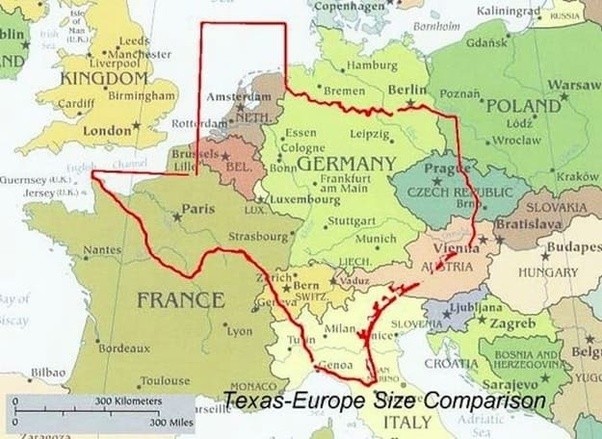Texas, the Lone Star State, is synonymous with vastness. Its sprawling landscapes and larger-than-life reputation often lead to the saying, “Everything’s bigger in Texas.” But when we place this Texan giant next to an entire country, particularly one as geographically unique as Japan, how does the size truly stack up? Let’s dive into a detailed comparison to understand just How Big Is Japan Compared To Texas.
Texas: A Colossus Within the United States
Texas rightfully earns its reputation as a large territory. Spanning an impressive 268,597 square miles (or 171,902,080 acres), it proudly holds the title of the second-largest state in the United States. To put this in perspective, Texas dwarfs many of its US counterparts. It’s approximately 1.65 times larger than California, a state often considered substantial in its own right, which measures 163,696 square miles. Only Alaska, with its massive 663,300 square miles, overshadows Texas in size within the nation.
Texas’s significant landmass also translates to a substantial economic and demographic presence. As of 2023, Texas is home to around 30.5 million residents and boasts the 8th highest GDP globally, a staggering $2.6 trillion. This economic output surpasses that of entire countries like Canada, Russia, and Italy, underscoring the sheer scale of Texas’s influence.
Why Texas Grew to Be So Big
The sheer size of Texas is not accidental; it’s deeply rooted in history. Unlike many other US states carved out of territories, Texas entered the Union as an already established, large independent republic. This unique entry meant it wasn’t subdivided like other new states. Historically, Texas was even more expansive, encompassing parts of present-day New Mexico, Colorado, Oklahoma, and Kansas. Exploring the rich tapestry of Texas history reveals the full narrative behind its expansive borders.
Japan: An Island Nation of Contrasts
Now, let’s shift our focus to Japan. As an island nation, Japan’s geography is distinctly different from the continental expanse of Texas. Japan’s total area is approximately 145,937 square miles. This makes it considerably smaller than Texas.
Despite its smaller land area, Japan is a global powerhouse, particularly known for its technological advancements and dense population. The population of Japan is around 125.8 million people, concentrated in a relatively smaller area compared to Texas’s 30.5 million. This stark contrast in population density is a key factor when comparing the two. Economically, Japan’s GDP stands at roughly $5 trillion, demonstrating a highly productive economy within its geographical constraints.
Head-to-Head: Texas vs. Japan Size Comparison
So, directly comparing how big is Japan compared to Texas, the numbers speak clearly:
- Texas is approximately 84% larger than Japan in land area. To visualize this, Texas is almost double the size of Japan.
- In more concrete terms, you could fit roughly 1.84 Japans within the borders of Texas.
While imagining countries fitting within states might seem abstract, it highlights the significant difference in landmass. Texas, in its vastness, provides expansive space, while Japan, though smaller, utilizes its area with remarkable efficiency and intensity.
Beyond Land Area: Population and Economic Dimensions
The size comparison extends beyond just square miles when we consider population and economic output.
- Population Density: Japan’s population density is significantly higher than Texas. With a larger population in a smaller area, Japan’s density is around 862 people per square mile, while Texas has a density of approximately 114 people per square mile. This illustrates dramatically different living environments and resource management approaches.
- Economic Output: While Texas boasts a substantial $2.6 trillion GDP, Japan’s economy is even larger at $5 trillion. This highlights Japan’s economic efficiency and productivity within its limited land area. However, when considering GDP per capita, Texas shows a strong figure, reflecting its own economic strengths.
Interesting Facts Highlighting Texas’s Size
To further emphasize the scale of Texas, consider these facts:
- World Population Fit: Theoretically, the entire world population could fit into Texas if we matched the population density of New York City.
- Country Size Comparison: If Texas were an independent country, it would be the 40th largest in the world, surpassing every nation in Europe in size.
- King Ranch: The largest ranch in Texas, King Ranch, is larger than the entire state of Rhode Island.
- Driving Distances: Driving across Texas from east to west takes about 11 hours, covering approximately 773 miles. Driving from north to south stretches to around 13 hours and 805 miles. These driving times alone give a sense of the state’s immense proportions.
Driving Across Texas: A Journey Through Vastness
The sheer drive times across Texas are a testament to its size. Whether you’re traversing east to west or north to south, you’re looking at a significant journey.
- East to West: The 773-mile drive from east to west can take around 11 hours of driving time, not accounting for stops. Starting near the Louisiana border and stretching to El Paso near New Mexico, this route showcases the breadth of Texas.
- North to South: An even longer journey awaits when driving from the northernmost to southernmost points. The 805-mile drive takes approximately 13 hours, traveling from the Oklahoma border down to Brownsville at the tip of Texas.
These long drives are not just about distance; they are about experiencing the changing landscapes and the sheer scale of the Texan territory.
Conclusion: Texas’s Immense Size Compared to Japan
In conclusion, when answering how big is Japan compared to Texas, it’s clear that Texas is significantly larger in land area. Texas boasts nearly double the landmass of Japan. However, size is just one dimension. Japan, despite being geographically smaller, compensates with a much higher population density and a larger overall economy. Both Texas and Japan represent significant entities on the global stage, each with unique strengths and characteristics shaped by their distinct geographical scales. Understanding these size comparisons provides valuable insights into the diverse ways countries and states develop and thrive.
